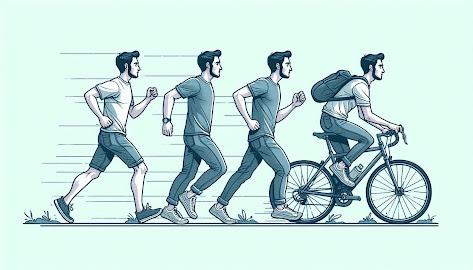Transformative Benefits of Regular Exercise
Exercising offers numerous benefits that enhance both physical and mental well-being:
- Improved Physiology: Exercise strengthens the heart, improves circulation, and helps prevent chronic diseases.
- Increased Energy Levels: Boosts stamina and reduces fatigue.
- Better Sleep Quality: Promotes faster sleep onset and deeper rest.
- Weight Management: Helps you burn calories and build more muscle.
- Improved Mental Health: Boosts mood and reduces anxiety and depression through endorphin release.
- Enhanced Cognitive Function: Improves memory and focus while reducing cognitive decline risk.
- Boosted Self-Confidence: Achieving fitness goals enhances self-esteem and body image.
Global Exercise Trends: A Closer Look at Physical Activity Statistics
Understanding worldwide exercise trends underscores the critical importance of physical activity:
- Only 23% of adults globally meet recommended exercise requirement, indicating that a staggering 77% are insufficiently active.
- Among overweight or obese individuals, only 30% engage in regular exercise.
- Countries with the Most Active Populations
- Mexico: Over 80% of the population exercises regularly.
- Sweden: Approximately 70% of adults are active.
- Norway: Around 65% engage in regular exercise.
- Australia: About 60% of adults participate in physical activity.
- United States: Roughly 50% meet exercise guidelines.
- Countries with the Least Active Populations
- Indonesia: Less than 10% meet exercise guidelines, often due to lifestyle factors.
- India: Approximately 15% engage in regular exercise, with many favoring traditional activities.
- Brazil: Around 20% exercise regularly, influenced by cultural events.
- Russia: About 25% are active, though harsh winters can limit outdoor activities.
- Light Intensity : Activities that require minimal effort and do not significantly elevate heart rate. Heart rate typically remains at 50-60% of maximum. You can talk and sing without puffing.
- Examples:
- Leisurely walking (under 3 mph)
- Light household chores (dusting, gardening)
- Gentle stretching or yoga
- Tai Chi
- Moderate Intensity : Activities that elevate heart rate and breathing but still allow for conversation. Heart rate increases to 50-70% of maximum. You can comfortably talk but not sing.
- Examples:
- Brisk walking (3-4 mph)
- Dancing (Zumba, ballroom)
- Cycling on flat terrain (10-12 mph)
- Swimming at a moderate pace
- Hiking on flat trails
- Vigorous Intensity : Activities that significantly increase heart rate and breathing, making conversation difficult. Heart rate reaches 70-85% of maximum. You can't say more than a few words without gasping for breath.
- Examples:
- Running or jogging (over 5 mph)
- High-Intensity Interval Training (HIIT)
- Competitive sports (basketball, soccer)
- Fast cycling (over 12 mph)
- High-energy aerobics classes
- Yoga: 200-300 calories/hour.
- Walking (Light): 200-400 calories/hour.
- Dancing: 300-500 calories/hour.
- Brisk Walking: 300-600 calories/hour.
- Cycling (Moderate): 400-800 calories/hour.
- Weightlifting: 400-600 calories/hour.
- Running: 600-1,000 calories/hour.
- HIIT: 600-1,200 calories/hour.
Finding the Best Exercise for You
Choosing the right exercise is crucial for motivation. Consider these factors: - Personal Preferences: Choose activities you enjoy.
- Variety: Mix different exercises to keep things exciting.
- Fitness Level: Start with light activities and gradually increase intensity.
- Goals: Tailor your routine based on your objectives, whether it’s weight loss, muscle gain, or overall health.
Making Exercise Fun
Who says working out has to be a chore? Here are some creative and enjoyable ways to spice up your fitness routine:
- Workout with Friends: Exercise is more fun with a buddy. Plan regular workout dates.
- Try New Activities: Explore different sports or fitness classes like kickboxing, yoga, or rock climbing to keep things fresh.
- Join a Sports League: Participate in recreational leagues for sports like soccer, basketball, or volleyball to combine fitness with socializing.
- Create a Fitness Challenge: Set up friendly competitions with friends or family, such as step challenges or workout streaks.
- Explore Nature: Go hiking, biking, or jogging in new parks or trails to enjoy the outdoors while exercising.
- Use Fitness Apps: Download apps that gamify workouts or track your progress to make exercising more interactive.
- Incorporate Music: Create a high-energy workout playlist or listen to podcasts while exercising to keep you entertained.
- Try Group Fitness Classes: Join classes like Pilates, spinning, or boot camp for a structured yet fun workout environment.
- Join a Virtual Community: Participate in online fitness challenges or groups to stay motivated and connected with others.
- Reward Yourself: Set up a reward system for achieving fitness milestones, like treating yourself to new workout gear or a fun outing.
Recommended Exercise Time
Making Exercise Fun
Who says working out has to be a chore? Here are some creative and enjoyable ways to spice up your fitness routine:
- Workout with Friends: Exercise is more fun with a buddy. Plan regular workout dates.
- Try New Activities: Explore different sports or fitness classes like kickboxing, yoga, or rock climbing to keep things fresh.
- Join a Sports League: Participate in recreational leagues for sports like soccer, basketball, or volleyball to combine fitness with socializing.
- Create a Fitness Challenge: Set up friendly competitions with friends or family, such as step challenges or workout streaks.
- Explore Nature: Go hiking, biking, or jogging in new parks or trails to enjoy the outdoors while exercising.
- Use Fitness Apps: Download apps that gamify workouts or track your progress to make exercising more interactive.
- Incorporate Music: Create a high-energy workout playlist or listen to podcasts while exercising to keep you entertained.
- Try Group Fitness Classes: Join classes like Pilates, spinning, or boot camp for a structured yet fun workout environment.
- Join a Virtual Community: Participate in online fitness challenges or groups to stay motivated and connected with others.
- Reward Yourself: Set up a reward system for achieving fitness milestones, like treating yourself to new workout gear or a fun outing.
Recommended Exercise Time
Adults: Aim for at least 150 minutes of moderate or 75 minutes of vigorous exercise weekly.
Children (6-17 years): At least 60 minutes of physical activity daily.
1.Hydrate
Drink at least 8-10 ounces of water before exercising.
Consume 7-10 ounces of water every 10-20 minutes during exercise.
Rehydrate with 16-24 ounces of water after your workout.
2. Rest
Schedule at least 1-2 rest days per week, depending on workout intensity.
Include active rest days with light activities like walking or gentle yoga.
3. Nutrition
Aim for a balanced diet consisting of 50-60% carbohydrates, 20-30% fats, and 10-20% protein.
Include a variety of colorful fruits and vegetables to ensure a range of nutrients.
Consider consulting a nutritionist for personalized dietary advice.
For more guidance on nutrition, you can check out our blog https://skibidi-rx.blogspot.com/2024/12/eat-like-yoda-feel-like-jedi-mindful.html
4. Post-Workout Snacks
Consume a snack within 30-60 minutes post-exercise.
Aim for a 3:1 ratio of carbohydrates to protein (e.g., a banana with peanut butter).
Keep easy-to-eat snacks on hand, such as Greek yogurt, protein bars, or smoothies.
5. Stretching
Perform static stretches for major muscle groups, holding each stretch for 15-30 seconds.
Focus on areas that feel tight or sore after your workout.
6. Sleep
Aim for 7-9 hours of quality sleep each night.
Establish a consistent sleep schedule by going to bed and waking up at the same time daily.
Limit screen time and caffeine intake in the hours leading up to bedtime.
If you want to know more about healthy sleeping habits – check out our post https://skibidi-rx.blogspot.com/2024/12/snooze-science-sleep-cycle-saga-hello.html
7. Foam Rolling
Use a foam roller on major muscle groups for 1-2 minutes each, focusing on tight areas.
Roll slowly, pausing on tender spots for 20-30 seconds.
8. Cold Therapy
Use ice packs on sore muscles for 15-20 minutes after intense workouts.
Consider ice baths for full-body recovery after particularly strenuous sessions.
By following these you can enhance your recovery process, reduce the risk of injury, and improve your overall fitness performance.
Danger Signs : When to Take a Break ?
While exercise is beneficial, it’s essential to recognize when your body needs a break. Here are some warning signs you need to watch for :
- Persistent Fatigue: If you feel excessively tired after workouts, it may be time to reassess your routine. Overtraining can lead to burnout and decreased performance.
- Increased Injuries: Frequent aches and pains may indicate that your body needs a break. Ignoring these signals can lead to more severe injuries.
- Mood Changes: If you feel more irritable, anxious, or down than usual, it might be time to take a step back. Exercise should enhance your mood, not detract from it.
- Sleep Issues: Difficulty sleeping can be a sign of overtraining. If you’re struggling to fall or stay asleep, consider incorporating more rest days or reducing workout intensity.
So that's all folks!! Exercise isn’t just a chore; it’s a vital part of a healthy lifestyle that can be enjoyable and fulfilling. Whether you’re sweating it out at the gym, dancing in your living room, or chasing after your kids, every bit of movement counts.




.jpeg)
.jpeg)




.jpeg)



0 Comments